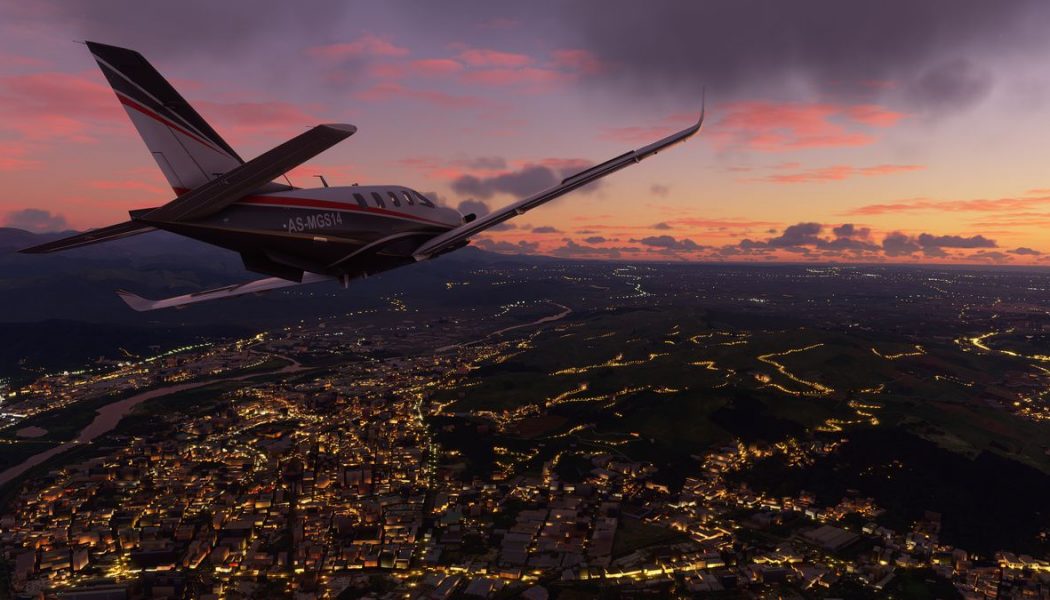Let’s play a quick game of word association: Microsoft — Windows? Excel? Xbox? All solid answers. But for me, for a while in the ‘90s at least, I would have immediately answered “Flight Simulator.” Microsoft Flight Simulator is the very first thing I can remember ever doing on a computer, sat on my granddad’s lap as we soared across blocky landscapes together with a Sidewinder joystick. It is one of Microsoft’s all-time iconic brands.
It’s also a brand that the company has more or less ignored in the past decade-plus. The last release, Flight Simulator X, came out in 2006, and a few years later, its developer, Aces Game Studio, was closed as part of widespread layoffs at Microsoft. A 2012 free-to-play spinoff called Microsoft Flight was less than well-received.
In just a few weeks, though, Microsoft is releasing perhaps the biggest upgrade to the series in its 38-year history. The new title, developed by French studio Asobo and simply called Microsoft Flight Simulator, is an ambitious attempt to leverage Microsoft’s Bing Maps data and Azure-powered procedural generation technology to render our planet in unprecedented detail.
I’ve been playing a pre-release alpha version for a couple of weeks, and it’s frankly astonishing. This is a full-throttle effort from Microsoft to re-create the natural world and the magic of flight. And while it carries the weight of an iconic series, it feels like it came from nowhere. Why is Microsoft reviving Flight Simulator now?
:no_upscale()/cdn.vox-cdn.com/uploads/chorus_asset/file/20790576/DayandNight.jpg)
“After Flight Simulator X, frankly, I think we just got more and more focused on Xbox and essentially just divested the team at the time,” Microsoft’s head of Flight Simulator, Jorg Neumann, tells me. “Why did we take so long to come back? Honestly, I’ve been at Microsoft for a good long time, and the desire to make another flight sim was truly always there. And people talked about it in the hallways, but it was always, ‘What are we going to add? What do we have to say? You know, can we actually make a meaningful step forward?’”
In more recent years, Neumann had been working on projects for HoloLens, Microsoft’s augmented reality headset. A demo called HoloTour, which let players fly around Rome and Machu Picchu, marked the first collaboration with Microsoft’s Bing Maps team. “I remember the first time I put on the headset, the sights and sounds were so real,” Neumann recalls. “I mean, I’ve never been to Peru, but it was real to me. And even then, in early 2016 or something. I just thought to myself, ‘Man, if we could just do this across the entire planet, wouldn’t that be something?’”
In 2017, Neumann got in touch with Asobo and asked if they’d be up for giving the project a shot. Using data of Microsoft’s home city of Seattle, which Bing Maps has rendered down to five-centimeter resolution with photogrammetry, Asobo took a few weeks to put together a demo of a Cessna flying downtown. Neumann then showed it to Phil Spencer, a VP at the time who is now the head of Xbox.
“He just looked at me and said, ‘Why are you showing me a video of Seattle with a plane?’” Neumann says. “And then the plane turned, and we flew over the Microsoft campus where we were sitting at that exact moment. And he’s like, ‘Is this real time? Is this running?’ And I’m like, ‘Yes, it is!’ And we knew then we had something special.”
Showing someone a video of a plane flying over a photorealistic Seattle is one thing, but convincing the player that they’re flying the plane themselves is quite another. Despite Asobo never having developed a flight sim before, Neumann thought the team would be a good fit on technical grounds. Asobo had previously shipped Fuel, a 2009 open-world all-terrain racer that used procedural techniques and satellite data to create what was at the time the largest video game environment yet.
[embedded content]
“We spent a long, long time to ingest what it is to be a simmer, what it means to be a simmer, what the simmer wants,” says Asobo co-founder Martial Bossard. “So we embraced what it is to bring a sim to the community, from going to flight school and understanding exactly what it is to be in a plane. You just have to go to a flight club, and you can talk to these kinds of people. They’re so passionate about what they are doing. And you know, we were not beginners. I’ve got the same story as you — I started computing with flight sims.”
Neumann is quick to point out that Asobo wasn’t starting from scratch. “I sent them the Flight Simulator X engine,” he laughs. “And the great thing was, they integrated the sim that we had one piece at a time. And pretty much from day one it worked. You know, sometimes you work on a product and for the first two years, nothing works. In this case, we could fly from literally day one and just bring up the different systems, which I think was key.”
I will say this about Microsoft Flight Simulator in its current state: it is very much a flight simulator — no more, no less. The focus so far has clearly been on the flight model and the underlying technology, and I think that’s for the best. Flying with a stick feels great, and the visuals are unparalleled. The reactive weather and clouds are a particular highlight. This afternoon, I just flew over my parents’ house in overcast England and felt like I was home. To be able to do that in the same package that lets you look for animals while flying over the African savannah is something special.
At this point, the detail of Flight Simulator’s world isn’t quite evenly distributed. Microsoft’s highest-quality data doesn’t cover all of the regions of the world, which means that a lot has to be tweaked manually, and unique objects like landmarks and bridges need to be built by hand because they can’t be generated with AI. I noticed this most when flying around my current home of Tokyo and spotting lots of famous buildings, but heading over to my previous city of Osaka and recognizing almost nothing.
“I think we’re going to get there pretty much everywhere,” Neumann says. “Commercial planes don’t fly everywhere, and some areas of the world are considered a little bit more remote. But those are actually the areas I’m going to focus on because you know western Europe and the US is good, right? But we want to focus on other areas because we think people have not been there, aviation hasn’t really gone there. There’s lots of fascinating terrain. And I mean, I think we can really inspire.”
“I spend a lot of time in Africa right now. I like flying around because it’s cool. And I just think we’re taking the industry of flight simming forward if we bring those areas up in quality because it’s been neglected. There’s all these third-party companies for decades now, they’ve made tons and tons of things, like a thousand airports or so have been modeled and 1,500 planes. But when you look at the geographical distribution of it, it’s not equal. And I think it should be — like really, this is going to be on my bucket list: ‘Make South America awesome.’ It is going to be on my bucket list.”
:no_upscale()/cdn.vox-cdn.com/uploads/chorus_asset/file/20790581/VividLandscape.jpg)
For me, the thought of flying around a beautiful rendition of our planet has such obvious mainstream appeal that I’m a little surprised Microsoft stuck so hard to the stripped-down flight sim template. Despite the Bing tie-in, for example, you’re essentially taking off at one airport and landing at another with little in the way of basic map navigation. I found myself flying with Google Maps open on an iPad whenever I wanted to look for a particular landmark. Bossard says the focus was on producing “a sim for simmers first,” with Bing’s data initially used to help produce flight plans and work on technical airport navigation data, but the studio is looking at integrating it in other layers as well.
Despite Microsoft Flight Simulator’s sim-heavy focus, though, it’s inevitable that this version will be checked out by a wide audience of people who have perhaps never tried a flight sim before. It’s launching on the PC version of Xbox Game Pass, for one thing, and there’s even a version for Xbox consoles following later — a first for the franchise. Microsoft also announced today that VR support is coming to the PC version, which could further expand the user base. How does Microsoft plan to introduce Flight Simulator to a new audience?
“Carefully,” Neumann says, repeating Bossard’s “sim for simmers” language. “Because if you forget that and you start thinking about larger audiences or gamers and those types of things, you lose focus on what your kernel is. When we talk about what you just said, people that might be new to sims, we call them newcomers, not gamers. Because we specifically left the sim in its state of open sandbox, which is important to simmers. And instead of dumbing anything down, we left the simulation exactly what reality is like and went for assistances and tutorials and those types of things to help newcomers onboard.”
I also wonder how Microsoft Flight Simulator will run on Xbox consoles from a technical perspective. I have a pretty good PC and a fast internet connection, which is important for streaming data, but I didn’t always get solid frame rates and visuals when running it at 1440p even on medium settings. On one flight, I took off from JFK and started to fly north from the southern tip of Manhattan. Everything looked great at first, but by the time I got to the Chrysler Building, some skyscrapers hadn’t properly rendered yet and looked like a slushy mess. This is still alpha software, so don’t take this as a review, but if you’re unsure of your PC’s capabilities, it might be a good idea to try out the Game Pass version first.
“We basically tried to make this an accessible simulator,” Neumann says. “Some people are speculating that you need some sort of supercomputer to run it. That’s definitely not the case. There’s some pretty modest video cards and PCs. And I think it’s very similar on Xbox where there’s an entire spectrum between Xbox One and Xbox Series X. There’s continued optimization regardless, but Xbox is certainly reinvigorating our optimization efforts, is probably the best way to say it.”
:no_upscale()/cdn.vox-cdn.com/uploads/chorus_asset/file/20790582/DynamicWeather.jpg)
Microsoft Flight Simulator can’t please everyone. There will undoubtedly be die-hard members of the flight sim community who find that certain things are missing, while others new to the idea might find it overwhelming. But what Microsoft is shipping from day one looks like it will be an incredible technical achievement, one with a central idea so compelling that it should be easy to appreciate the release for what it is.
And this is only the first step. “When I pitched this product, the thing that Phil [Spencer] said to me was, ‘Hey, Jorg, if we go in, we’re going to stay in,’” Neumann says. “We know we can’t just go make a product and boogie and do something else. That is not how this works. We’re taking on a responsibility here for a hobby, and people trust us and we know that. It is our oldest franchise in the company. It is older than Windows and Office. It has a special place.”
“I often struggle with finding the right words — I think there is sort of an intrinsic human desire to fly. I don’t know if it’s flight or if it’s the perspective change, I don’t know what it is, but it’s something like that. There’s something really special about seeing initially where you live from a different perspective, and then going other places. It has nothing to do with the simulation, even. I can show it to my daughters. My dad is 91. Almost everybody can relate to it because it’s real. It is so close to feeling real.”
Microsoft Flight Simulator is coming to Windows 10, Steam, and Xbox Game Pass on August 18th.










